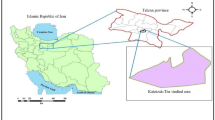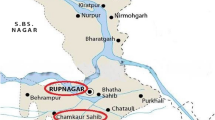Abstract
Indoor radon is a serious health concern and contributes about 10% of deaths from lung cancer in the USA and Europe. In this study, radon and thoron levels of 20 multi-floor buildings on the campus of Isfahan University of Medical Sciences were measured in cold and hot seasons of a year. SARAD- RTM1688 radon and thoron monitor was used for measurement. The annual effective dose of radon exposure was also estimated for residences on the campus. The results showed that radon concentration was below the WHO guideline (100 Bq m− 3) in most of the buildings. The ranges of radon were from 3 ± 10% to 322 ± 15% Bq m− 3 in winter and from below the detectable level to 145 ± 8% Bq m− 3 in summer. Mostly, the radon concentration in the basement or ground floors was higher than upper floors, however, exceptions were observed in some locations. For thoron, no special trends were observed, and in the majority of buildings, its concentration was below the detectable level. However, in a few locations besides radon, thoron was also measured at a high level during both seasons. The average annual effective dose via radon exposure was estimated to be 0.261 ± 0.339 mSv y− 1. The mean excess lung cancer risk (ELCR) was estimated to be 0.10%. It was concluded that indoor air ventilation, buildings’ flooring and construction materials, along with the geological structure of the ground could be the factors influencing the radon concentration inside the buildings. Thus, some applicable radon prevention and mitigation techniques were suggested.



Similar content being viewed by others
References
Nakhli A. Radon and the environment. Iran J Nucl Energy. 2017;119:19–20.
Ghiyasinejad M, Katozi M. General lessons in radiation protection. Iranian nuclear energy organization. Derbid publication, 2000. (in Persian)
WHO. Word health organization guidelines for indoor air quality: selected pollutants. WHO Regional Office for Europe, Copenhagen, Denmark; 2010.
Pawel DJ, Puskin JS. The US Environmental Protection Agency’s assessment of risks from indoor radon. Health physics. 2004;87(1):68–74.
Charles M. UNSCEAR Report 2000: sources and effects of ionizing radiation. J Radiol Prot. 2001;21(1):83.
Darby SC, Whitley E, Silcocks P, Thakrar B, Green M, Lomas P, et al. Risk of lungcancer associated with Residential radon exposure in south-e-west England: acase-control study. Br J Cancer. 1998;78(2):394–408.
Laurier D, Valenty M, Tirmarche M. Radon exposure and the risk of leukemia: a review of epidemiological studies. Health Phys. 2001;81:277–88.
National Research Council. Health effects of exposure to radon: BEIR VI, 1999. ISBN:0-309-52374-5. http://www.nap.edu/catalog/5499.html
Schoenberg JB, Klotz JB, Wilcox HB, Nicholls GP, Gil-del-Real MT, Stemhagen A, Mason TJ. Case-control study of Residential radon and lungcancer among New Jersey Women. Cancer Res. 1990;50:5250–6254.
Jean-Christophe L, Favre F, Firmin P, Célestin T, Daniel DW. Residential radon and lung cancer: results form an ecologic study in the Swiss Alps. Cancer Res. 2005;40:440–6.
Letourneau EG, Krewski D, Choi NW, Goddard MJ, McGregor RG, Zielinski JM, Du J. Case-control study of Residential radon and lung cancer in Winnipeg, Manitoba, Canada. Am J Epidemiol. 1994;140:310–22.
Pershagen G, Akerblom G, Axelson O, Clavensjo B, Damber L, Desai G, Enflo A, Lagarde F, Mellander H, Svartengren M, Swedjemark GA. Residential radon exposure and lung cancer in Sweden. N Engl J Med. 1994;330:159–64.
Askari M, Hassanvand MS, Naddafi K, Zarei A, Yousefi M, Alimohammadi M. Assessment of indoor radon concentration in residential homes and public places in south of Tehran. Iran Environ Earth Sci. 2019;78(10):1–10.
Yarahmadi M, Shahsavani A, Mahmoudian MH, Shamsedini N, Rastkari N, Kermani M. Estimation of the residential radon levels and the annual effective dose in dwellings of Shiraz, Iran, in 2015. Electron Physician. 2016;8(6):2497.
Gillmore G, Jabarivasal N. A reconnaissance study of radon concentrations in Hamadan city. Iran Nat Hazards Earth Syst Sci. 2010;10(4):857–63.
Mortazavi SMJ, Ghiassi-Nejad M, Rezaiean M. Cancer risk due to high level of natural radon in the inhabitants of Ramsar. Iran Int Congr Series. 2005;1276:436–7.
Shahsavani S, Shamsedini N, Tabatabaei HR, Hoseini M. Indoor radon concentrations in residential houses, processing factories, and mines in Neyriz, Iran. J Environ Health Sci Eng. 2019;17(2):979–87.
Bavarnegin E, Fathabadi N, Moghaddam MV, Farahani MV, Moradi M, Babakhni A. Radon exhalation rate and natural radionuclide content in building materials of high background areas of Ramsar, Iran. J Environ Radioact. 2013;117:36–40.
Keller G, Hoffmann B, Feigenspan T. Radon permeability and radon exhalation of building materials. Sci Total Environ. 2001;272:85–9.
Tondeur F, Rodenas J, Querol A, Ortiz J, Juste B. Indoor radon measurements in the city of Valencia. Appl Radiat Isot. 2011;69(8):1131–3.
Ciolini R, Mazed D. Indoor radon concentration in geothermal areas of central Italy. J Environ Radioact. 2010;101(9):712–6.
Oikawa S, Kanno N, Sanada T, Abukawa J, Higuchi H. A survey of indoor workplace radon concentration in Japan. J Environ Radioact. 2006;87(3):239–45.
Chen J, Schroth E, MacKinlay E, Fife I, Sorimachi A, Tokonami S. Simultaneous Rn-222 and Rn-220 measurements in Winnipeg, Canada. Radiat Prot Dosim. 2009;134(2):75–8.
Hadad K, Doulatdar R, Mehdizadeh S. Indoor radon monitoring in Northern Iran using passive and active measurements. J Environ Radioact. 2007;95(1):39–52.
USEPA. Protocols for radon and radon decay product measurement in homes, Offic of Air and Radiation. United States Environmental Protection Agency Publication 402-R-92-003. 1993.
Abd Ali FS, Mahdi KH, Jawad EA. Humidity effect on diffusion and length coefficient of radon in soil and building materials. Energy Procedia. 2019;157:384–92.
Annex D, United Nations Scientific Committee on the Effects of Atomic Radiation. Sources and effects of ionizing radiation. Investigation of I. 2000;125.
Valentin J. International Commission on Radiological Protection. The 2007 recommendations of the international commission on radiological protection. Annals of the ICRP. ICRP Publication. 2007;103:2–4.
Mokhtari M, Jafari N, Mohammadi A, Hajizadeh Y, Ghanbari R, Nemati S, Abdolahnejad A. Temporal and spatial trends of airborne asbestos fiber concentrations in the urban areas of Yazd, Iran. Int J Environ Sci Technol. 2019;16(6):2657–66.
Kermani M, Jafari AJ, Gholami M, Arfaeinia H, Yousefi M, Shahsavani A, Fanaei F. Spatio-seasonal variation, distribution, levels, and risk assessment of airborne asbestos concentration in the most industrial city of Iran: effect of meteorological factors. Environ Sci Pollut Res. 2021;28(13):16434–46.
Kavasi N, Nemeth C, Kovacs T, Tokonami S, Jobbagy V, Varhegyi A, et al. Radon and thoron parallel measurements in Hungary. Radiat Prot Dosim. 2007;123(2):250–3.
Kumar M, Kaushal A, Sarin A, Kumar R, Sharma N. Radon/thoron and progeny levels in dwellings: Regional variations and effect of dwelling characteristics–A case study in Jalandhar district of Punjab, India. Indoor Built Environ. 2018;27(5):706–14.
Kurnaz A, Kucukomeroglu B, Cevik U, Celebi N. Radon level and indoor gamma doses in dwellings of Trabzon, Turkey. Appl Radiat Isot. 2011;69(10):1554–9.
Abdelzaher M. Seasonal variation of radon level and radon effective doses in the Catacomb of Kom EI-Shuqafa, Alexandria, Egypt. J Phys. 2011;77(4):749–57.
Al-Ghamdi S, Khougear G, Baig M. Indoor radon levels and distribution in occupied and unoccupied residential buildings in student’s campus at King Saud University, Riyadh, Saudi Arabia. J King Saud Univ Sci. 2007;19:73–81.
Shang B, Chen B, Gao Y, Wang Y, Cui H, Li Z. Thoron levels in traditional Chinese residential dwellings. Radiat Environ Biophys. 2005;44(3):193–9.
Sathish L, Nagaraja K, Ramanna H, Nagesh V, Sundareshan S. Concentration of radon, thoron and their progeny levels in different types of floorings, walls, rooms and building materials. Int J Radiat Res. 2009;7(1):1.
Günay O, Aközcan S, Kulalı F. Measurement of indoor radon concentration and annual effective dose estimation for a university campus in Istanbul. Arab J Geosci. 2019;12(5):171.
Kulalı F, Günay O, Aközcan S. Determination of indoor radon levels at campuses of Üsküdar and Okan Universities. Int J Environ Sci Technol. 2019;16(9):5281–4.
Loffredo F, Savino F, Amato R, Irollo A, Gargiulo F, Sabatino G, et al. Indoor Radon Concentration and Risk Assessment in 27 Districts of a Public Healthcare Company in Naples, South Italy. Life. 2021;11(3):178.
Clement CH, Tirmarche M, Harrison J, Laurier D, Paquet F, Blanchardon E, et al. Lung cancer risk from radon and progeny and statement on radon. Ann ICRP. 2010;40(1):1–64.
Hassanvand H, Hassanvand MS, Birjandi M. Indoor radon measurement in dwellings of Khorramabad city, Iran. Iran J Med Phys. 2018;15(1):19–27.
Hassanvand H, Birjandi M, Amiri A, Hassanvand M, Kamarehie B. Investigation of indoor radon concentration in dwellings of Aleshtar (western part of Iran) and estimation of the annual effective dose from exposure to radon. Int J Radiat Re. 2019;17(4):659–66.
USEPA. Protocols for radon and radon decay product measurements in homes. Washington, DC: US Environmental Protection Agency, Air and Radiation; Publication 402-R-92-003, 1993.
Ting DSK. WHO handbook on indoor radon: a public health perspective. Abingdon: Taylor & Francis; 2010;100–102.
Acknowledgement
This research was carried out with financial support of the vice chancellery for research of Isfahan University of Medical Sciences [Grant No: 193082].
Funding
Isfahan University of Medical Sciences [Grant No: 193082]
Author information
Authors and Affiliations
Corresponding author
Ethics declarations
Conflict of interest
The authors declare that there is no conflict of interest.
Additional information
Publisher’s Note
Springer Nature remains neutral with regard to jurisdictional claims in published maps and institutional affiliations.
Rights and permissions
About this article
Cite this article
Teiri, H., Nazmara, S., Abdolahnejad, A. et al. Indoor radon measurement in buildings of a university campus in central Iran and estimation of its effective dose and health risk assessment. J Environ Health Sci Engineer 19, 1643–1652 (2021). https://doi.org/10.1007/s40201-021-00720-y
Received:
Accepted:
Published:
Issue Date:
DOI: https://doi.org/10.1007/s40201-021-00720-y




